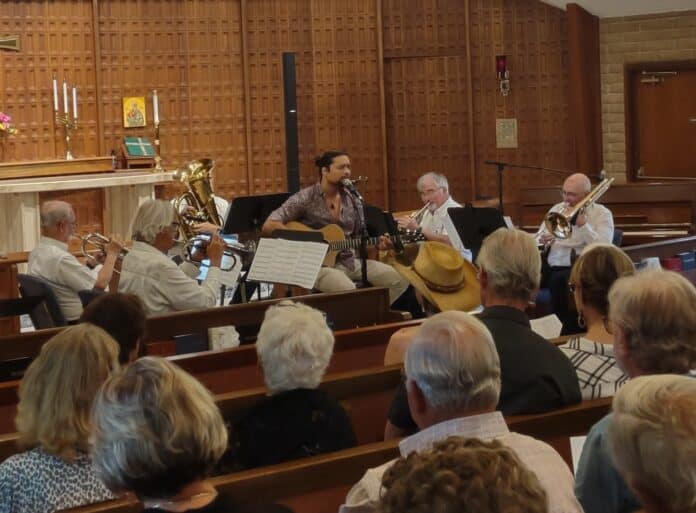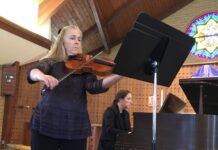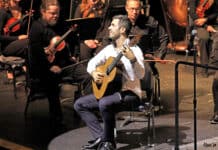
“There’s not enough brass in Sedona, so we’re going to try to tune it up,” lead trumpeter Dave Len Scott told the audience at St. Andrew’s Episcopal Church on the afternoon of Sunday, July 23, early in the Sedona Brass Quintet’s first program of the musical season, “Contrasts in Brass.”
The quintet went for a classical opening with a brass setting of the aria “Sento la gioia” from George Frederic Handel’s opera “Amadigi di Gaula,” adapted to the strengths of the quintet’s players. Scott described the work’s genesis as involving “a Prussian composer writing an Italian opera for the Queen of England [Queen Anne] based on a work by a French author that was set in ancient Greece.”
“Sento la gioia,” in which the singer exults over the joy that sparkles in his breast as Cupid’s star does in the heavens, is a selection that lends itself readily to instrumental performance, with the vocal part, originally written for the alto castrato Nicolini, taken in this case by an agile trumpet.
The fivesome began the aria with a moderate tempo, dignified rather than ecstatic. Exploring its simple elegance, they pulled back the curtain of time to give the audience a glimpse of one of those periods in music history when virtuosity was celebrated for its own sake and form was intended as a temptation to improvisation. The quintet did full justice to the liveliness of Handel’s spirits in the passage, showing off the joy and confidence at the core of the Baroque repertoire. As an Anglicized, romanticized recreation of the pagan world, the piece was also a very apt selection for the visual space of St. Andrew’s Episcopal Church.
While Scott said that Victor Ewald’s “Symphony for Brass Choir” had a Tchaikovsky feel to him, in performance it betrayed more of an Elizabethan revival approach, including a hint of similarity to Erich Wolfgang Korngold’s setting of Christopher Marlowe’s “The Passionate Shepherd to His Love,” before moving to a bolder sound halfway between jazz and traditional styles.
The quintet was clearly at home with the symphony’s harmonies, hitting its stride by the second movement. Joe Jackson was especially smooth on French horn and the third movement included sparkling coordination between Scott and Ron White on second trumpet.
A special treat was Scott’s own orchestration of Henriette Bosmans’ “Sonata for cello and piano,” with, of course, no cello or piano but plenty of horn and trombone. One of the many Jewish musicians forced into hiding during World War II, Bosmans spent those years playing underground concerts and rescuing her mother from a concentration camp. The sonata, however, dates to 1919, and its brooding themes, which translated well into a full brass setting, reflected the discombobulation that followed an earlier global war.
Bosmans’ approach in this work might be described as musical cubism, all odd angles and impossible staircases, much like the house on the Feldmanstrasse in 1967’s “Casino Royale” or the contemporary weird fiction of H.P. Lovecraft. It was a highly appropriate choice as a would-be monsoon storm gathered abortively overhead.
The quintet also presented a trio of folk songs, leading off with “Loch Lomond” in an upbeat arrangement by tubaist Gerry Kuhn that was no simple arrangement and instead threatened to turn into variations on a theme as the players volleyed the notes back and forth. They retained the traditional opening flourish of the era for Samuel A. Ward’s “America the Beautiful,” which had the building vibrating. As for Joseph Brackett’s “Simple Gifts,” a tune better known to most listeners from Aaron Copland’s “Appalachian Spring” or Michael Flatley’s “Lord of the Dance,” it offered them a chance to display a beautifully-coordinated introduction that started with Scott and Jackson before trombonist Tim Thorne and the rest of the quintet joined in to put across one of the most confident, infectious passages in music with triumphant clarity. A cheerful rendition of “My Spirit Be Joyful,” from Johann Sebastian Bach’s cantata “Wir müssen durch viel Trübsal,” rounded out the first part of the concert.
Following intermission, the quintet was joined by local songwriter Näthan Saith Gangadean to perform half a dozen of his own compositions with brass accompaniment. Reflecting on Gangadean’s recent show at Posse Grounds Park, Scott told the audience, “It could have been better, and I remember thinking, ‘What he needs is a brass quintet!’” For his part, Gangadean called the experience of playing with the quintet one of being surrounded by “angels arriving with the trumpets blaring.”
“Into Infinity,” performed by Gangadean on piano with Scott accompanying him on trumpet, hung on the edge of developing into something striking and powerful, of launching toward that infinity it referenced — but fizzled, although its contemplative style meshed well with the Episcopalian environment. “Meant to Be,” also on piano, had a stronger effect as its explosive crescendo diminished in a way that shocked and then lulled the audience into an immobilizing sense of security that left them silent at the conclusion until they belatedly realized the music had ended.
While Gangadean described the piano as his native instrument, his guitar stylings made a better complement to the quintet. “Hillsides of Eden” had somewhat of a late-career Amy Grant feel, brisk but not really getting anywhere. However, it did give Scott a chance to show off his virtuosity with an extended passage of ornamentation. “Step Outside” was more folksy and offered another opportunity for Scott’s trumpet acrobatics as well as a strong trombone role. The optimism of “Child of the Heart” came across through the bright interplay of guitar and brass, which lent a tropical flavor to the music, and grew progressively more energetic until it finished in an a capella chorus with the listeners clapping along.
The afternoon’s true triumph of fusion, however, was “I’m Alive,” in which the quintet’s accompaniment did not simply counterpoint Gangadean’s guitar but brought the dynamics of the song to life to an astonishing degree. The strings gained depth and dimension from the brass, as in an orchestral setting, while the brass were enlivened by the guitar stringing them along and provided backing that illustrated and enhanced the lyrics. By far the most successful of the six arrangements, it offered a tantalizing glimpse of the future potential of such collaborations.





















